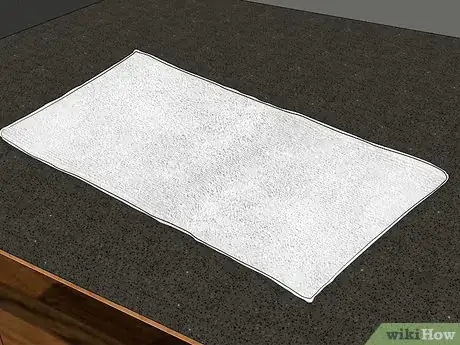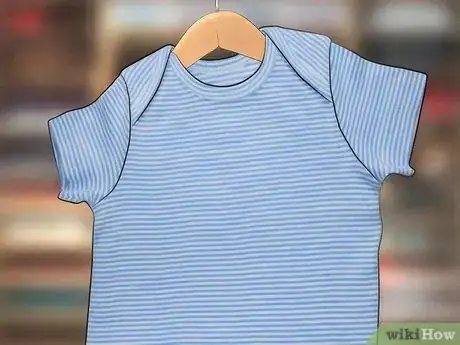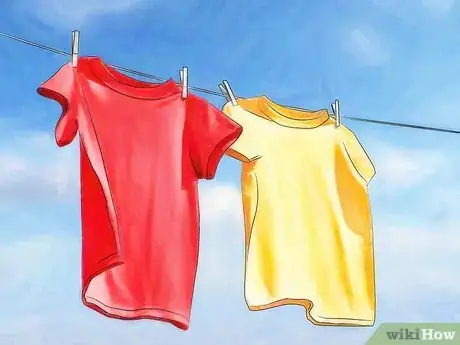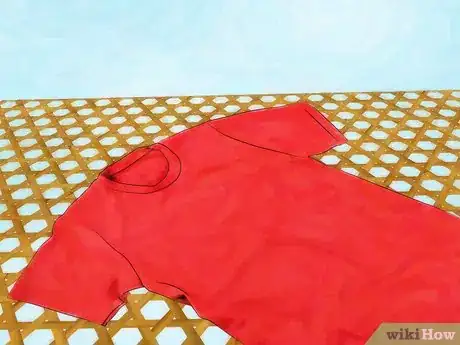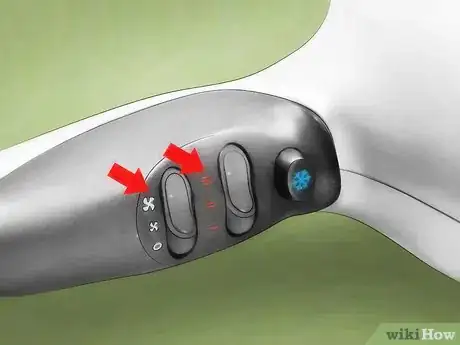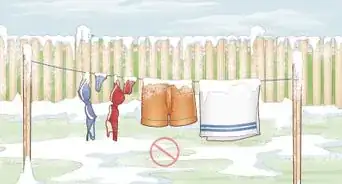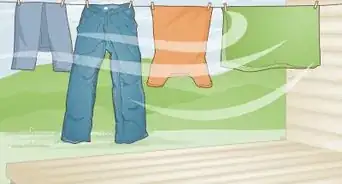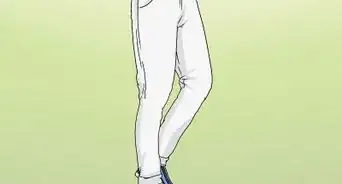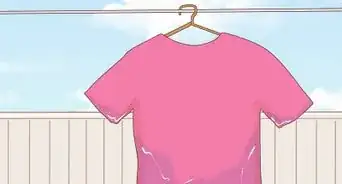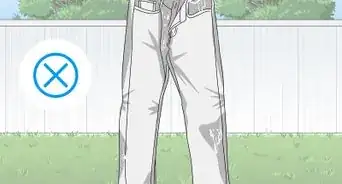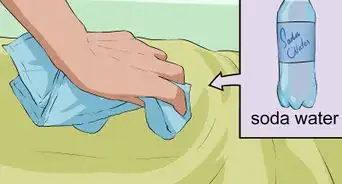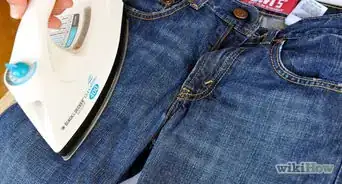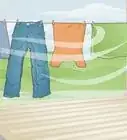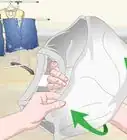This article was co-authored by Ayad Mirjan. Ayad Mirjan is a Dry Cleaner and Laundry Specialist and the Founder of OrangeBag®, a toxin-free, sustainable, Los Angeles-based laundry and dry cleaning delivery service. Ayad has over four years of experience in the industry and he specializes in providing easy laundry and dry-cleaning solutions to professionals, families, and businesses. Ayad received his Bachelor's degree from The University of California, San Diego, and an MBA from Henley Business School. He is also a board member of the Entrepreneur's Organization Accelerator (EOA).
This article has been viewed 184,355 times.
In today's world we often feel the need to save time any way we can. Laundry is no exception. Waiting for the dryer is typical when doing laundry. Many clothes dryers cannot keep up with the washer when doing multiple loads. You can save money by line drying many of your clothes even if you do not have a clothes line. You may be able to avoid using your drier completely.
Steps
Wringing Excess Water From Your Clothing
-
1Spread a large towel across a flat surface. The wringing technique is a fast and easy way to wring out the excess water from a wet article of clothing. You will use your towel to absorb all of the excess water, so choose a big, fluffy towel.[1]
- Your garment should not overlap the towel at all. Lay your garment flat on top of the towel, making sure the entire garment is on the towel.
-
2Roll your garment in the towel. Begin by placing your wet garment on the towel. Take one end of the towel, and roll it tightly with the garment inside. As you roll your garment in your towel, it should look like a log or sausage. The ends of the towel should be swirled, like a cinnamon roll.[2]Advertisement
-
3Drain the excess water by picking up your rolled towel and twisting it as tightly as possible. As you do this, the towel will absorb water from the wet garment. Once you have done this, unroll the towel and remove your garment – it should feel barely damp at this point.[3]
- Only wring out one garment at a time so that you can get the most excess water out of each garment. Once your towel has become very damp, switch towels. Your towel must be relatively dry to absorb the most amount of water.
- If you're drying small items, such as socks, spread them out on your towel so that you can wring them at the same time. As long as these small items aren't touching, it will be like wringing out one large piece of clothing.
Hanging Clothing to Dry
-
1Hang your wet clothing on hangers. After you've squeezed out the excess water, hang your clothing on hangers to fully dry. Hang one article of clothing on each hanger, and leave space between each hanger to allow air to get to each piece of clothing.[4]
- The best hangers have notches or hooks to keep shoulder straps from slipping off.
- Shower curtain rods make for great clothes hanging rods. If you don't have a shower curtain rod, make a temporary hanging rod by propping a broom (or any other long, cylinder shaped item) between 2 even surfaces.
-
2Use a drying rack to dry your clothes indoor. Drying racks are typically stand alone wooden racks that have different levels to hang multiple pieces of clothing on. Drying races can be purchased online or at most home goods or big box stores.
- Place small items like socks, underwear, or washcloths on the lower racks.
- Place large / long items like sheets, towels, and pants on the higher racks. This will prevent them from touching the ground.
- Put the rack near a heat source. This could be a heating duct, a radiator, or sunny window. This will help speed up the drying process. Don't place the rack too close to space heaters or radiators to avoid the risk of fire.
-
3Hang your clothes on a clothesline to dry outside. If you live in warmer, sunnier weather, take advantage of being able to dry your clothing outside. All you'll need to make your own clothesline is a strong rope that you can tie between two trees or two poles. Your clothes should take a few hours to dry.
- Avoid hanging your bright and dark colors in direct sunlight, as the sun could make the colors fade.
- Hang your line high enough off the ground so that if you hang something heavy, like a blanket or something denim or made from other heavy fabrics, it will not touch the ground and get dirty.
- Pin your clothes onto the line using clothes pins. These can be purchased online or at most home goods or big box stores.[5]
-
4Lay certain items flat to dry. Because of their heavy or stretchy fabric, certain items may get stretched out if you hang them to dry. Flat air drying is preferred for items like sweaters and other knit garments. You should shape the item as you flay it flat to dry so that it dries into the proper shape.
- For example, you can wash a down jacket in a large tub.
- Then lay it flat to dry.
- Remember to fluff it up to avoid the down from sticking together.
Using a Blowdryer
-
1Hang your damp clothing on a rod or place it on a flat surface. When you're ready to dry your clothing with a blowdryer, start by hanging it or placing it on a flat surface that is located near a power outlet. Using a hair blowdryer will speed up the drying process if you're in a rush and can't wait for your clothing to air-dry. Start by wringing out the excess water from the clothing, and then finishing with a blowdryer.
-
2Turn your blowdryer to a warm and high setting. Most blowdryers have low and high settings for the pressure of the airflow – put your blowdryer on high. You should also put your blowdryer on warm instead of cool – this is for the temperature of the air. To avoid damaging your clothing, hold the blow-dryer a few inches away from your fabric. Blow-dry the entire surface of the garment, front and back. Continuously move the blowdryer so as not to burn the fabric in any spots.
- For fabrics prone to shrinkage (like wool), use the cool heat setting instead of warm.[6]
-
3Blow-dry the pockets, collars, or any other embellishments a little longer than the rest of the garment. The areas of clothing that have more layers or thicker fabrics will take longer to dry. Once you've dried the entire garment, make sure to go back and give those thicker areas of fabric a little extra blowdrying time.[7]
Community Q&A
-
QuestionWhat can I do if the towel method didn't work on my clothing and I have no access to a dryer?
 Community AnswerAir-dry the clothing after using the towel. If you do not have access to an outdoor clothesline, you can make one yourself by using two poles and a bit of sturdy clothesline. Otherwise, you can hang the clothes to dry on your shower curtain pole, using clothes hangers. It will take a while to dry, but the results are about the same as using a conventional dryer.
Community AnswerAir-dry the clothing after using the towel. If you do not have access to an outdoor clothesline, you can make one yourself by using two poles and a bit of sturdy clothesline. Otherwise, you can hang the clothes to dry on your shower curtain pole, using clothes hangers. It will take a while to dry, but the results are about the same as using a conventional dryer. -
QuestionIs it okay to dry my clothes without direct sunlight?
 Community AnswerYes. It is perfectly fine to dry your clothes without the sun. The sunlight just helps accelerate the drying process.
Community AnswerYes. It is perfectly fine to dry your clothes without the sun. The sunlight just helps accelerate the drying process. -
QuestionHow do I dry my blanket if it's soaking wet, even too wet for it to be in a dryer?
 Community AnswerPut a few towels over the wet blanket, then take an iron and put it on full heat. Move the iron over the whole blanket slowly.
Community AnswerPut a few towels over the wet blanket, then take an iron and put it on full heat. Move the iron over the whole blanket slowly.
References
- ↑ http://home.onehowto.com/article/tricks-to-dry-clothes-faster-without-a-dryer-1985.html
- ↑ https://www.ovoenergy.com/blog/lifestyle/how-to-dry-your-clothes-in-a-flash-without-a-tumble-dryer.html
- ↑ http://home.onehowto.com/article/tricks-to-dry-clothes-faster-without-a-dryer-1985.html
- ↑ https://www.ovoenergy.com/blog/lifestyle/how-to-dry-your-clothes-in-a-flash-without-a-tumble-dryer.html
- ↑ http://www.rodalesorganiclife.com/home/organic-way-dry-your-clothes
- ↑ http://joannefaith.com/2011/02/03/fabrics-guide-wool-cotton-polyester-viscose-silk/
- ↑ http://wardrobeadvice.com/how-to-use-your-hair-dryer-to-quickly-dry-your-clothes/
